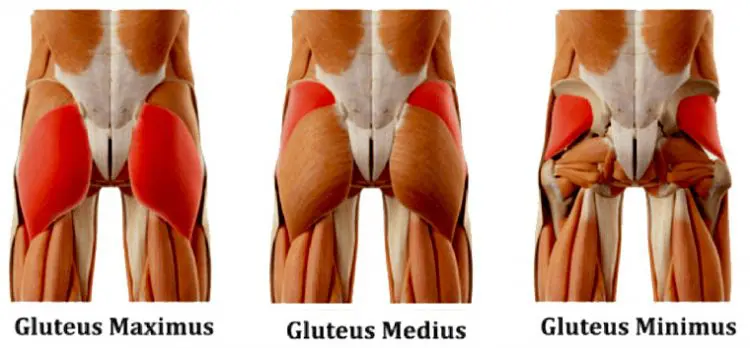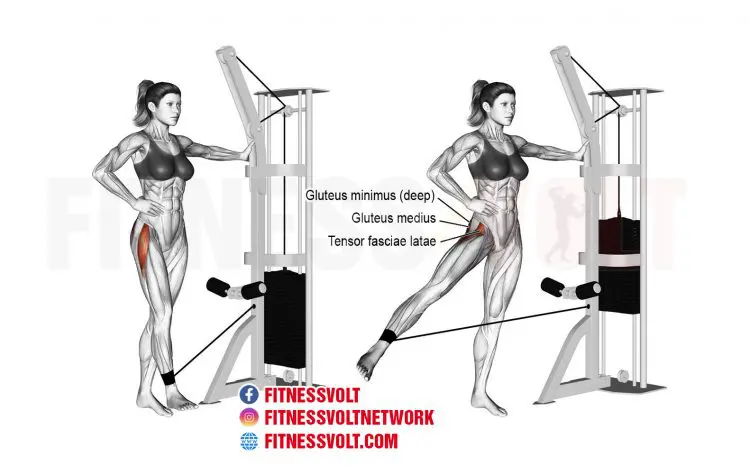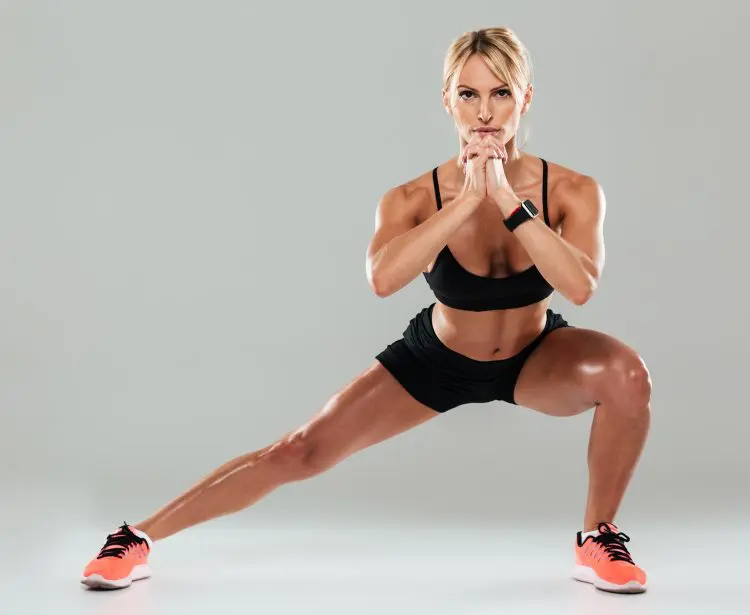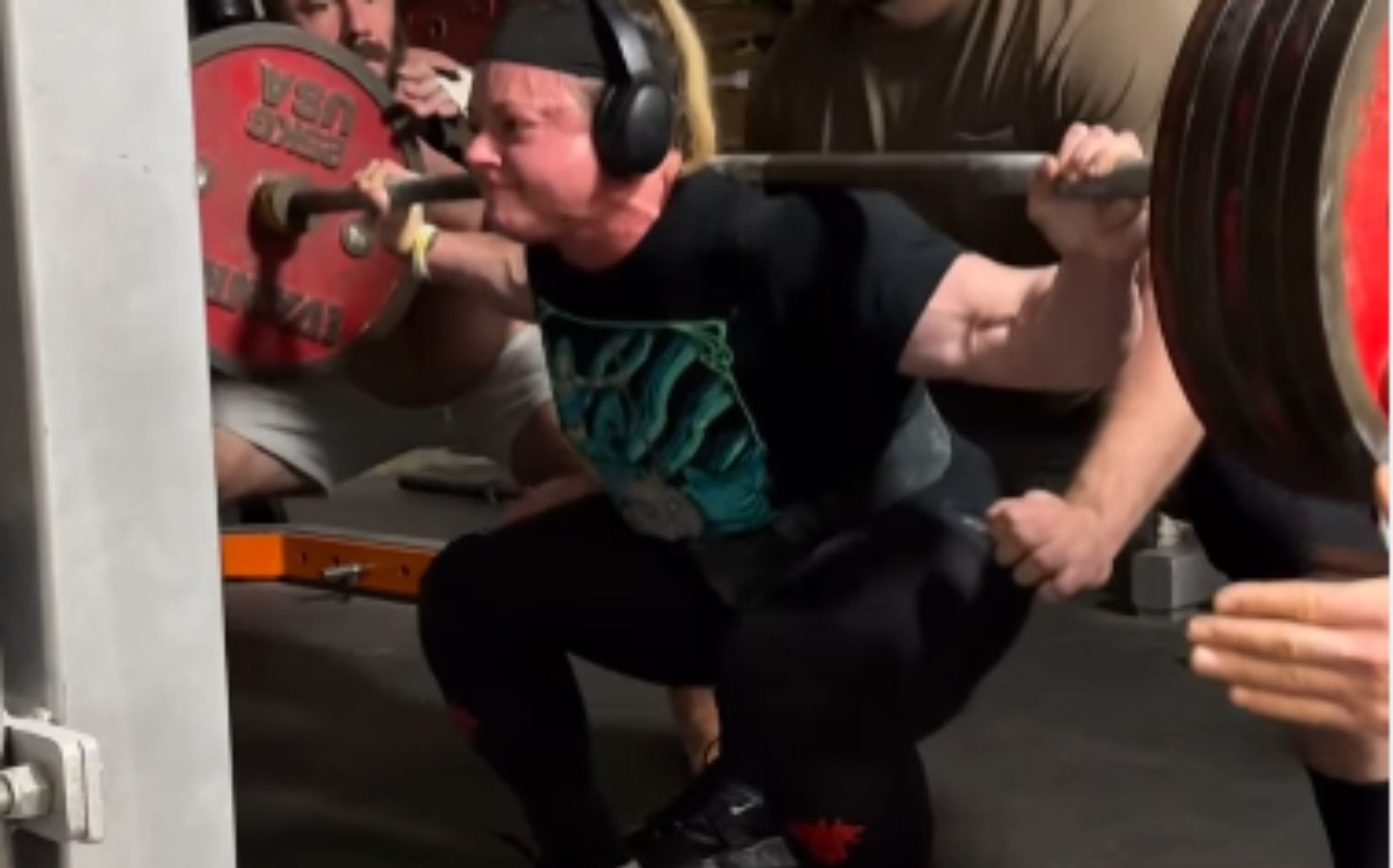Today, you’re going to learn things about your butt you didn’t even know existed. Don’t worry, this is not one of those articles which does nothing more than ask you to squat for a better rear. We’re guessing you’re already doing that on the advice of a gym bro.
A strong, tight, firm, and round behind is desired by men and women alike unless you are proud of your chicken legs and loose-fitting denim. A strong butt doesn’t only add to the aesthetics of your physique but it can also help build a stronger core, back, and knees.
Gluteal Anatomy

The gluteal (scientific name for your tush) muscles consists of three main muscles: gluteus maximus, medius, and minimus. While the gluteus maximus does all the heavy lifting (literally) and combined with the medius is the muscle you check out in the mirror, the minimus plays a vital role in shaping and keeping your booty firm, and hip stabilization and abduction.
We’ll be focusing on the gluteus minimus in this article. As the name suggests, the minimus is the smallest of the three muscles. Gluteus minimus is a triangular-shaped deep-seated muscle that runs from the hip bone to the top of the thigh bone.
For the booty nerds: you have six hip abductor muscles. The gluteus medius, gluteus minimus, and tensor fasciae latae (TFL) are the primary muscles, and the piriformis, sartorius, and superior fibers of the gluteus maximus are the secondary muscles. All these muscles play a role in gluteus minimus exercises.
Finding Minimus
Level Up Your Fitness: Join our 💪 strong community in Fitness Volt Newsletter. Get daily inspiration, expert-backed workouts, nutrition tips, the latest in strength sports, and the support you need to reach your goals. Subscribe for free!
The gluteus minimus lies deep to the gluteus maximus, gluteus medius and tensor fasciae latae. The medius overlaps most of the minimus muscle. If the gluteus maximus, medius, and minimus were siblings, the minimus would be the shyest of the three.
The gluteus minimus starts at the gluteal surface of the ilium (the widest and largest of the three parts of the hip bone) and connects to the proximal end of the femur (the knob on the end of your thigh bone). The minimus and medius are almost the same in terms of structure, nerve, blood supply, and function. When we said the glute muscles are siblings, we meant it.
Role of the Gluteus Minimus
You might be wondering, “Why are the buttocks made up of three muscles?”, “Why can’t there be just one blob of meat?” We understand your pain. If the butt was a single muscle, it’d be much easier to train and develop, but like with other things in life, God has his ways.
The gluteus minimus helps you rotate and move your thighs from side to side, and it does so in link with the gluteus medius. The gluteus minimus in congruence with the medius helps in maintaining hip level while walking or running.
If it weren’t for the gluteus minimus and medius, your hips would drop every time you took a step. And that would be a very awkward sight – if you ask us. The minimus also helps with other functions like flexion (bringing your leg forward) and extension (bringing your leg backward).
Importance of Training the Gluteus Minimus
Imagine the trouble you’d have to face if you had difficulties performing any of the functions mentioned above. And the hips dropping with every step – that would be embarrassing. Weak or tight gluteus minimus muscles could also cause serious stability and mobility problems.
The benefits of training the gluteus minimus are not limited to aesthetics. You might come for the much sorted after side dents in the butt but you’ll stay for the advantages listed below:
Improves Performance
Hip stability is important for virtually all exercises and everyday tasks like walking, running, jumping, and even rotating to your sides. Weak gluteus minimus can take away the explosiveness and agility from your movements. Ever seen a high endurance athlete with a weak tush? We neither.
Maintains Pelvic Alignment
If you have a job that requires you to sit on your computer most of the day, there’s a good chance that your gluteus minimus muscles aren’t getting the exercise they need. It could cause your gluteus minimus muscles to become weak and overly tight, leading to pain and injury.
With every single step, you take, your gluteus minimus contract to maintain pelvic alignment. Feeble gluteus minimus would cause your hips to drop downwards as you pick the other leg off the floor resulting in several lower body problems over time.
While squats are great, they don’t work the minimus muscles to avoid chronic hip pain, improper knee tracking, and balance issues. Using the abductor and adductors machines in the gym will ensure that you never have pelvic alignment issues, something that many people struggle with in old age.
Great For Recovery From Injuries
The great thing about training the gluteus minimus is that it is not reserved for the best of your days. You should make the gluteus minimus exercise a part of your routine even if you’re recovering from an injury as most of these exercises require you to resist gravity with your body weight.
The gluteus minimus exercises will help you with regaining hip strength and stability. If you want to take your side butt training to the next level, you could add regression exercises to the mix – more on this later.
Since the gluteus minimus lies underneath the medius, you can’t completely isolate and train that muscle. While performing the gluteus minimus exercises, you’ll be working your other gluteal muscles as well as your other hip abductor muscles.
Causes of Weak Gluteus Minimus
Apart from the fact that you’re not training the gluteus minimus in the gym, sitting for long periods, standing with your weight shifted to one side, and sitting with your legs crossed for extended periods of time can cause sluggish minimus muscles.
Now, we won’t bore you with the problems that could occur with weak and tight gluteus minimus as we’ve already dug into it by mentioning the importance of training the muscles. But there is one other problem that we want to address here.
Weak gluteal minimus can cause pain in any area from your lumbar back down to your feet, as your joints will have unwarranted pressure. A decreased hip mobility is another sign of weak minimus muscles which can cause lower back problems.
Being the smart machinery it is, your body begins to compensate for the lack of function and mobility in your hips, which causes other lower body muscles to take over duties that they shouldn’t. Most people with weak gluteus minimus complain of pains in their lower bodies but they have no idea their little tush is the cause of the trouble as the pain doesn’t necessarily come from that area.
14 Gluteus Minimus Exercises
1. Hip Abduction Machine
Let’s start with the machine specifically designed to train your abductors. If you have a gym membership and have access to this machine, make the most of it. Pro tip: don’t make eye contact with bros at your gym while performing this exercise.
Steps:
- Sit down on the machine with your back resting against the pad and place the side of your thighs against the knee pads.
- Select a weight that you can handle with control. If you’ve never trained your gluteus minimus or haven’t used the machine before, you don’t want to go too heavy on this exercise as it can cause an injury.
- Push the pads outwards while maintaining tension on your side butt. Pause for a couple of seconds at the top of the movement and return with a slow and controlled motion.
- Repeat for the recommended reps.
Modification: If you train at your home, you can replicate the effect of the machine by placing a resistance loop band across your knees while being seated on a chair. Remember – the goal is to push using your glutes without using any momentum.
2. Leg Outside Pulses
If you thought that a bodyweight exercise can’t engage your gluteus minimus muscles like a machine, wait until you give this exercise a try.
Steps:
- Get into the starting position on all fours with your hands directly under your shoulders.
- While keeping your leg straight, extend it to the side until it is perpendicular to the rest of your body.
- Pulse your leg up and down for the desired reps.
- Get a fire extinguisher to douse the flames on your butt.
3. Cable Hip Abductions

Since we’re talking about the gym exercises, let’s go over another exercise that you mostly see the ladies perform.
Steps:
- Stand beside the cable pulley machine and hold onto the pole. Tie the ankle straps to your ankles and place the pulley at the lowest setting.
- While maintaining a neutral posture, lift your leg as high as you can without bending or jerking it.
- Return to the starting position, repeat for the recommended reps and switch to the other leg.
Read also: Cable Hip Abduction Exercise Guide and Videos
Level Up Your Fitness: Join our 💪 strong community in Fitness Volt Newsletter. Get daily inspiration, expert-backed workouts, nutrition tips, the latest in strength sports, and the support you need to reach your goals. Subscribe for free!
4. Side Lunges
Side lunges are your best bet at developing those dents in the sides of your butt if you’re a beginner or are limited by space or equipment.
Steps:
- Stand with your feet placed wider than shoulder-width apart.
- Bend at your right knee while keeping your left leg straight and slowly shift your weight to your right side.
- Return to the starting position and repeat on the opposite side.
5. Fire Hydrants
Fire hydrants might look easy but will annihilate your rear and core.
Steps:
- Get into position on all fours with your hands under your shoulders.
- While keeping your leg bent at the knee, lift it to the side until it’s at hip height. At the top of the movement, your working leg should be parallel to the floor.
- Return to the starting position and repeat for the required number of reps before switching sides.
Mod: You could also involve your core to a higher degree in this exercise by performing the static version. Lift your leg and hold it in position for 15 seconds before returning to the starting position. Pro tip: don’t perform this exercise outdoors near a fire hydrant.
6. Curtsy Lunges
Curtsy lunges can require some practice to get used to but we highly recommend that you add them to your exercise arsenal because of their effectiveness.
Steps:
- Stand with a shoulder-width stance with your hands folded in front of your chest.
- While keeping your left foot in place, step back with your right foot and place it a little outside your left hip.
- Bend at both knees to lower your body to the floor. Make sure your left knee is directly over your right ankle and your back is straight.
- Go until your right knee is a couple of centimeters off the floor.
- Return to the starting position and repeat with the left leg.
7. Clamshells
Clamshells are a physical therapist’s favorite. It’s better to perform these exercises before you’re forced to schedule an appointment.
Steps:
- Lie down on your side with your legs bent at your knees. Your lower legs should be perpendicular to your torso at the beginning of the exercise.
- While keeping your feet together, open your legs by lifting your top knee.
- Slowly lower it back down to the starting position.
- Repeat for the recommended reps before switching sides.
Mod: add a resistance band to the mix to increase the intensity of the exercise.
8. Banded Single-Leg Press
Single-leg exercises like the Bulgarian split squat, single-leg squat, and single-leg deadlift are incredibly effective at building that side butt as single-leg exercises engage the gluteus medius and minimus for stability. If you’re a gym regular, you’d know that the single-leg exercises mentioned above can be a little hard to perform. The banded side leg presses are just as good as they mimic the single-leg squats and presses.
Steps:
- Lie down with your back against the floor.
- Bend your right leg until your knee is over your chest.
- Wrap the resistance band around the right foot and hold onto it with both your hands.
- Slowly press with your right heel until your leg is straight.
- Return to the starting position and repeat for the recommended reps before switching sides.
9. Side Plank with Hip Abductions
You’re entering the pro territory with this exercise. Make sure your focus is on your hips throughout this exercise. It’ll be easy to lose your target as the core starts to chime in.
Steps:
- Get into the side plank position by supporting your body weight using your forearm and keeping your feet together.
- Raise your top leg as far as you can without bending at your knee, squeeze your side glutes, and come down slowly.
- Repeat for the recommended reps.
Mods: 1) Side plank hip abductions could be hard if you’re a beginner. If that’s the case, you should perform a modified version of the plank with your legs bent at your knees. Bending at your knees will take off some tension from your core and will make the exercise a little easier.
2) If you’re a complete rookie, you can chug out the planks and perform the hip abductions while laying on your side.
10. Side Plank Pulses
Since most of the tension is placed at the center of your body while you’re in a plank, the side planks are a great way to build the gluteus minimus and medius. The side plank pulses are a great exercise for people who can’t hold the side plank due to a weaker core.
Steps:
- Get into the side plank position and slowly lower down your body until your butt is a few centimeters off the floor.
- Return to the starting position and repeat for the desired reps.
11. Plank Jacks
This is the last plank exercise on the list. Planks jacks are an explosive exercise that will kick your butt. For the plank jacks to have the most effect on your rear, raise your hips slightly above the normal planking position. You don’t want your core to take over the exercise.
Steps:
- Get into the orthodox planking position with your elbows directly under your shoulders and the feet placed shoulder-width apart.
- Mimic performing a jumping jack but while in a planking position.
- Jump both feet at the same time to the sides and bring them back in as soon as they touch the floor.
- You could perform this exercise for a set number of reps or have a time-stop in place.
As you get better at this exercise, consider adding a resistance band to your lower legs. The added resistance will help recruit the gluteus minimus and medius.
12. Front Plank With Hip Abductions
We know what we said about the side planks being the last planking exercise – we lied. Get over it. Consider this a bonus.
Steps:
- Get into the orthodox planking position.
- Lift your right foot off the floor and move it to the right side as far as you can within a normal range of motion without bending at the knee.
- Return to the starting position and perform the rep with the other leg.
This exercise can be an alternative to the cable hip abductions.
13. Lateral Walk With Bands
Lateral walks are an exercise that is not hard to perform, but the results are pretty impressive.
Steps:
- Place a resistance loop around your ankles or above your knees.
- Get into an athletic stance by bending slightly at your knees and pushing your butt down and back.
- Step to your right with your right foot while maintaining tension on your side butt.
- Step your left foot to your right so that your feet are shoulder-width apart again.
- Repeat for the recommended reps on one side before going in the opposite direction.
14. Glute Bridges
Glute bridges are probably the easiest exercise on the list. To get the most out of the exercise, at the top of the movement, squeeze your butt as if your life depends on it.
Steps:
- Lie down on your back with your arms to the side.
- Bend your legs and place your feet flat on the floor.
- Drive your hips up so that your body makes a straight line from your knees to your upper chest.
- Hold the position for 30-45 seconds, focusing on contracting your glutes, hamstrings, and core.
As you get better at performing this exercise, you could add to the difficulty by performing these variations:
- Glute bridge with resistance bands
- Glute bridge with weight
- Single-leg glute bridge
- Elevated glute bridge
Wrapping Up
The gluteus minimus is such a small muscle group that most people probably have never heard of it. It’s probably also the reason most people have weak side butts. It’s time booty training is viewed with a holistic approach and is not just limited to squats, donkey kickbacks, or hip thrusts.
We have compiled this comprehensive gluteus minimus training guide, and it has all the exercises you’ll ever need to develop the muscles and build that dent in your side butt. We’d love to see what you do with the newfound tools.
Interested in measuring your progress? Check out our strength standards for Hip Abduction, Bulgarian Split Squat, Deadlift, and more.











